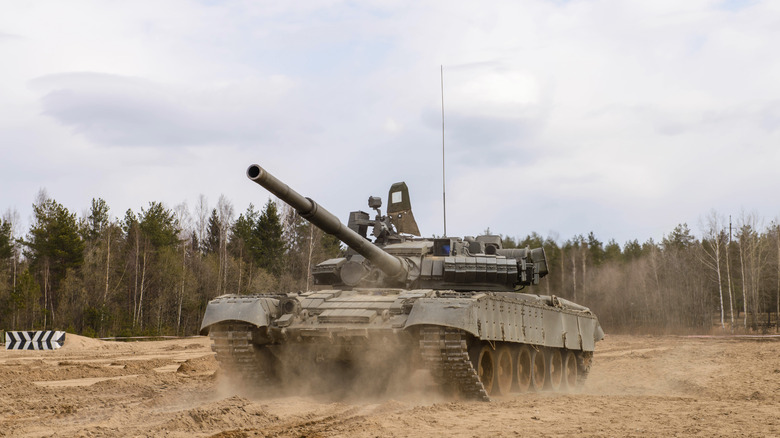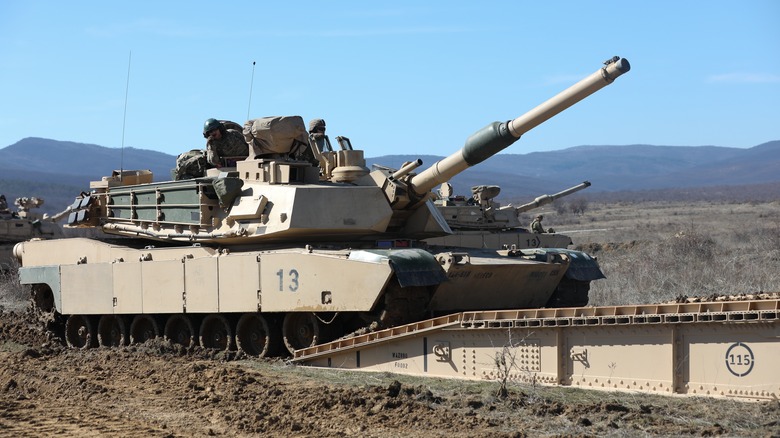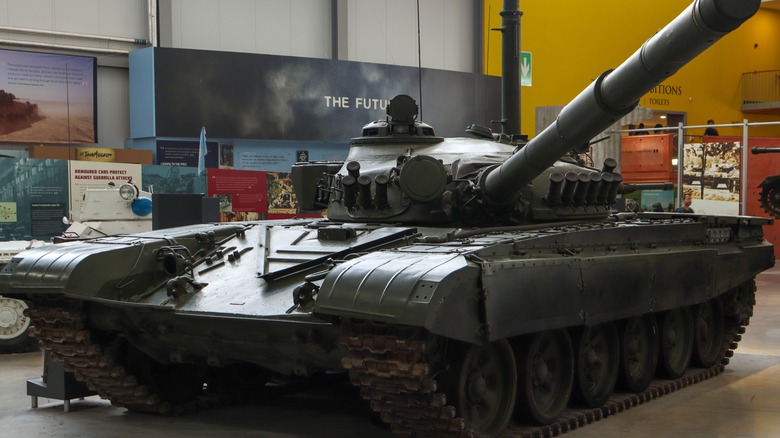Why Some Russian Tanks Explode Spectacularly & Throw Their Turrets In The Air When Hit
For civilians looking at a tank on display in a museum, it can look all but impenetrable. Unfortunately for those servicepeople who crew them, that's not the case. Engineers have introduced and developed a range of defensive measures, including active armor that deflects the force of a hit, but there's really no getting around the fact that drones, RPGs, and armor-piercing rounds continue to threaten even the most reinforced tanks. Armored shell or not, there are volatile elements within a tank's body where a hit can be utterly devastating. In the case of some Russian tanks, a hit can cause a huge, dramatic explosion and the loss of the turret. It might not be quite clear what's happening in these cases, but it's all down to the way that the ammunition is stored.
The so-called Jack-in-the-box effect is caused by the internal design of certain models like the T-72, T-84, and T-90 tanks. These tanks automatically load their ammo, keeping the ammunition exposed and otherwise vulnerable within the tank's turret. A hit to the turret could penetrate it and ignite all those shells, killing the crew and launching the turret into the air with tremendous force.
It's quite literally a fatal flaw, and it can be terrible for the survivability of both crew and the tank. The T-72 is a very interesting Soviet tank with some design decisions that set it apart from its counterparts, but other tanks have developed sophisticated solutions to this weakness.
Why some other tanks aren't as vulnerable as the Russian models
There's no getting around the fact that tanks are going to need the appropriate amount of ammo for their missions. It's just as inevitable that, should this ammo be struck by an incoming attack, it's probably going to ignite. However, it isn't strictly necessary for the crew to be within range of the potential explosion when it does.
In direct contrast to Russia's T-72, Major General Paul Eaton, speaking to CNN in April 2022, called the M1 Abrams "probably the best tank in the world. It's certainly the best I've ever ... worked with." One reason for this, per Eaton, is the defensive capacity of the Abrams in this regard. It's more resistant to the jack-in-the-box effect that plagues its Russian counterparts because of the armored storage section that keeps the ammo separate from the compartment the crew is in during operation. This doesn't mean that armor-piercing weaponry can't get to it, but it is a much safer arrangement.
To further reinforce the tank, the Abrams uses blowout panels, an innovation that has saved lives. These panels surround the ammunition and, should it be set off by a hit on the tank, will force the power of the explosion away from the tank's occupants. Sadly, it's impossible for the safety features of every vehicle to outright prevent disasters, let alone a tank in the midst of combat. All the same, any advantage a tanker can have on their side might be vital. Unfortunately, it's not a feature found on the Russian tanks.
Why the T-72 and other Soviet tanks don't have these defensive measures
The autoloader system used by the likes of the T-72 means that the ammo it uses can't be stored separately from the crew, so they're in more danger than the crews of other tanks like the formidable M1 Abrams, even though the M1 does have weaknesses of its own. The T-72 tanks are rather old, having been introduced in the early 1970s, so it's to be expected that they may lack certain modern developments like blowout panels.
However, modifications to include such things would be counter to the central point of the T-72. It was created to be efficient and less costly, with the autoloader playing into this by reducing the required number of crew members. The T-72 just needed three crew members, not a fourth to load the turret.
Additionally, separating the shells from the crew's area inside the tank and including blowout panels would have made the model considerably bigger and heavier, which the T-72's designers were keen to avoid. With this design, the T-72 was kept to a relatively low 41.5 tonnes, and its versatility and simplicity lead to its becoming one of history's most popular main battle tank. Though it has its considerable benefits, the dramatically increased risk to the crew must also be taken into account.


